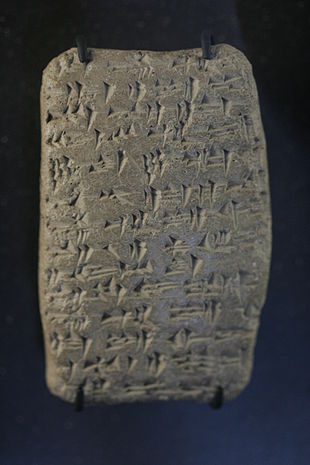

Line 3: "ardu-ka"-(

 , "Servant-yours" at, (line 4)-feet-yours, Lord-mine).
, "Servant-yours" at, (line 4)-feet-yours, Lord-mine). (very high-resolution expandable photo)
ARAD, (also ÌR or NITÁ) is the capital letter-(majuscule) Sumerogram for the Akkadian language word "ardu", for servant. It is used especially in the introduction to the Pharaoh: for example "To King, Lord-mine (of Gods(pl)-mine, Sun-god-mine), message thus Xxxxxx, "Servant-yours"-(271). It is also used extensively in Amarna letter texts, the author, usually the "man of a city", (or scribe), where there is a constant reminder that he is a "servant", or "servant-yours"-(of the Pharaoh). Many letters are giving city-state status reports, but many are also requesting help with the Egyptian army troops-(Archers (Egyptian pitati), supplied by the Pharaoh).
Epic of Gilgamesh
The cuneiform character for ARAD, ÌR, and NITÁ: ![]() in the Epic of Gilgamesh is used in the following numbers: ARAD-(2), ÌR-(2), and NITÁ-(2) times. It is used numerous times in the Amarna letters but especially from the city-states of Canaan-(Ki-Na-Ha-A-(
in the Epic of Gilgamesh is used in the following numbers: ARAD-(2), ÌR-(2), and NITÁ-(2) times. It is used numerous times in the Amarna letters but especially from the city-states of Canaan-(Ki-Na-Ha-A-(![]() -Ha-
-Ha-![]() ) in the letters-(EA 30:1, for example)).
) in the letters-(EA 30:1, for example)).
References
- Held, Schmalstieg, Gertz, 1987. Beginning Hittite, Glossaries, Sign List, p. 56, ÌR.
- Parpola, 1971. The Standard Babylonian Epic of Gilgamesh, Glossary, pp. 119-145, p. 121, ardu, for "servant".
- Held, Schmalstieg, Gertz, 1987. Beginning Hittite. Warren H. Held, Jr, William R. Schmalstieg, Janet E. Gertz, c. 1987, Slavica Publishers, Inc. w/ Glossaries, Sign List, Indexes, etc., 218 pages.
- Parpola, Simo; Mikko Luuko & Kalle Fabritius (1997). The Standard Babylonian, Epic of Gilgamesh. The Neo-Assyrian Text Corpus Project. ISBN 951-45-7760-4. (Volume 1) in the original Akkadian cuneiform and transliteration; commentary and glossary are in English.